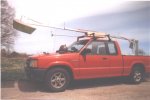Doug Riley
Platinum Member
- Joined
- Jan 11, 2004
- Messages
- 6,982
Technical discussions on this Forum sometimes make me uneasy.
Once someone posts some numbers, or predictions about a given design based on numbers, the discussion soon drifts into the "nihilist zone." That is, the zone where theory means nothing. Where the simple, universal laws of nature mean nothing. Where only one's own direct experience matters. Where eggheads get beat up on the playground.
Some good ol' boy pilots go so far as to refer to design theory as the realm of "paper a--holes."
Folks, we'd never have advanced beyond our caves if had not been able to work out the laws of nature. The laws of nature ALWAYS work. You don't have to keep dropping the rock over and over to see if it will fall this time. It will. As Ayn Rand once said, the universe is not a haunted house.
A force X, pushing on a lever Y feet long produces a torque of X x Y foot pounds. Always. Even when the "bestest" good ol' boy (G.O.B.) is at the stick. The G.O.B. may be able to stay alive in an aircraft that is trying desperately to turn upside down, but that doesn't make it a good design.
We all recall the joke about the guy who jumped off the Empire State Building. He commented, as he went past the 50th floor, "So far, so good." Only in "theory" was he in any danger at that moment; he wasn't dead yet. Was he safe?
Aircraft that are "proven" safe by cut-and-try alone should not be deemed adequate, IMHO. They may be right against the edge, like the Empire State jumper. The next clueless newbie may just find the coffin corner that was there all along.
A craft that "proves" itself by testing should also "prove out" on paper. That's where the marginal nature of a particular approach may show its ugly head -- or OTOH where we might learn that the craft has very generous margins and isn't close to the edge at all.
I'm not aiming this rant against any particular aircraft. I'm targeting a particular form of toxic thinking that can impede progress in aircraft design.
And, by the way... the advocates of numerical design (the "paper a--holes") tend to be high-time gyro pilots with 40 or so years in this activity and/or a few thousand hours under their belts.
Once someone posts some numbers, or predictions about a given design based on numbers, the discussion soon drifts into the "nihilist zone." That is, the zone where theory means nothing. Where the simple, universal laws of nature mean nothing. Where only one's own direct experience matters. Where eggheads get beat up on the playground.
Some good ol' boy pilots go so far as to refer to design theory as the realm of "paper a--holes."
Folks, we'd never have advanced beyond our caves if had not been able to work out the laws of nature. The laws of nature ALWAYS work. You don't have to keep dropping the rock over and over to see if it will fall this time. It will. As Ayn Rand once said, the universe is not a haunted house.
A force X, pushing on a lever Y feet long produces a torque of X x Y foot pounds. Always. Even when the "bestest" good ol' boy (G.O.B.) is at the stick. The G.O.B. may be able to stay alive in an aircraft that is trying desperately to turn upside down, but that doesn't make it a good design.
We all recall the joke about the guy who jumped off the Empire State Building. He commented, as he went past the 50th floor, "So far, so good." Only in "theory" was he in any danger at that moment; he wasn't dead yet. Was he safe?
Aircraft that are "proven" safe by cut-and-try alone should not be deemed adequate, IMHO. They may be right against the edge, like the Empire State jumper. The next clueless newbie may just find the coffin corner that was there all along.
A craft that "proves" itself by testing should also "prove out" on paper. That's where the marginal nature of a particular approach may show its ugly head -- or OTOH where we might learn that the craft has very generous margins and isn't close to the edge at all.
I'm not aiming this rant against any particular aircraft. I'm targeting a particular form of toxic thinking that can impede progress in aircraft design.
And, by the way... the advocates of numerical design (the "paper a--holes") tend to be high-time gyro pilots with 40 or so years in this activity and/or a few thousand hours under their belts.

